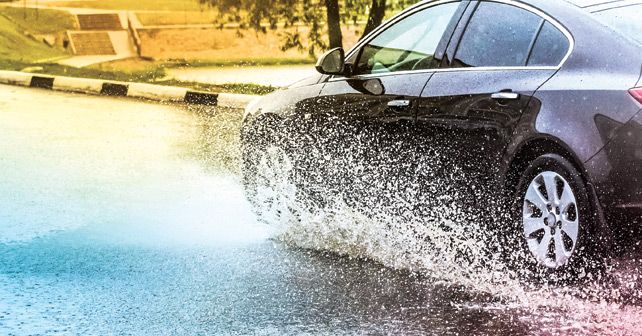
That driving in the rain involves risks is common knowledge, but there are steps that you can take to mitigate these risks.
The first half hour after it starts to rain is most critical, for the water mixes with grime and oil on the road – making it dangerously slippery. Hydroplaning is another serious threat during heavy rain or rain storms. The tyres of a car begin to ride on a film of water like a pair of water-skis, losing all contact with the road surface and making the vehicle vulnerable to a complete loss of control. Underinflated, worn or bald tyres can hydroplane at relatively low speeds. Therefore, check your tyre pressure regularly and slow down to avoid any risk of hydroplaning.
The monsoon is a welcome change of season, but, along with bringing a brief respite from the unbearable heat of the scorching summer sun, it also brings with it waterlogged roads and knee-deep potholes filled with rain water. All this inevitably leads to chaotic conditions for motorists and pedestrians alike. And even though such a scene recurs every year, we never seem to be prepared to deal with it. Heavy water logging not only disrupts traffic but also life in general. So, how can we deal with it? The government and concerned municipal authorities must be vigilant to ensure smooth and instant removal of water from roads by using high-power pumps and keeping the drainage system under check. Motorists and other road users can do their bit by taking the following precautions:
Gauge the situation
Waterlogged roads are a common sight in the rainy season. So, the first thing that you should do as a motorist is to gauge the depth of the water before taking a leap of faith. Check the oncoming traffic or notice the car in front as they wade through water. You can also check the level of water by using dividers, trees, pavements, etc., as reference points.
Wait
The best thing you could do to avoid being stuck in an unwanted situation is to… wait. Don’t rush into anything and don’t drive in waterlogged areas if possible. Stay calm, analyse the situation and only proceed when you know it’s safe to do so. Also, try and maintain a safe distance from vehicles ahead and behind your car, it’ll give you some extra time to react in case things go awry.
Stay at a steady speed
While driving through roads filled with water, stay on the accelerator pedal all the time. Of course, you don’t have to floor it but, just maintain a steady and constant speed. Try to stay in one gear as well and avoid gear shifts. This is done in order to keep the water from entering the exhaust system. Also, put the AC off and open some windows to ensure that even if the car shuts down, you can get out safely.
Don’t try too hard
Trying to crank a stalled car while stuck in waterlogged roads is one of the most common mistakes – which could turn out to be a very expensive one too! If you find your vehicle has stalled because of waterlogging, this could be due to the fact that the air intake system has sucked in some water. By trying to start the vehicle over-and-over again, the intake system will eventually send water into the car’s engine – resulting in a condition called hydrostatic lock. This essentially means your car’s engine is seized!
Un-fog
Rain causes humidity and temperature differences when you’re driving. This results in the windshield of your vehicle getting all fogged up, thereby, impairing your vision. In such cases, you could use the defogger with ‘fresh air’ mode and not on ‘recirculation’, or roll down your window slightly and turn off your air conditioner.
Of course, check your wipers before the onset of the monsoon, and follow these tips to stay out of trouble. Happy motoring...
T.K. Malhotra is the President of the Automobile Association of Upper India (AAUI).























Write your Comment